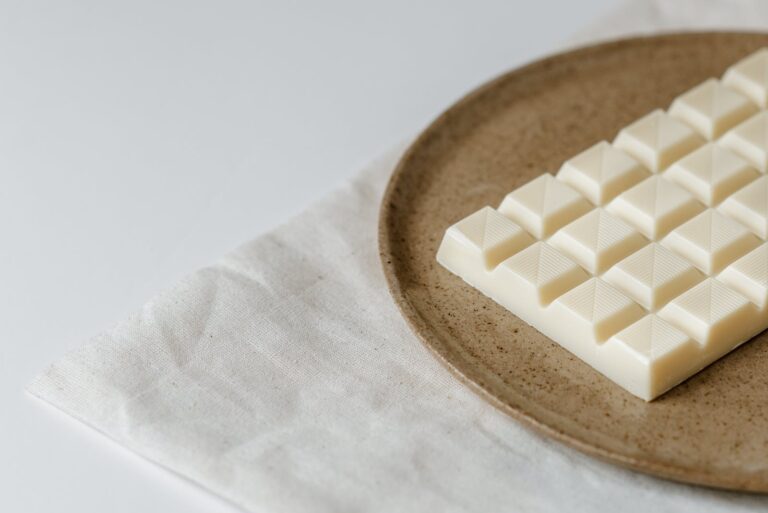Craving something sweet and creamy? White chocolate might just be your go-to indulgence. While often overshadowed by its darker counterpart, white chocolate offers its own unique appeal. Not only does it provide a delightful taste, but there are also some white chocolate benefits that might surprise you.
Despite its rich flavor, white chocolate isn’t just about taste; it’s got a few tricks up its sleeve. From giving you a mood lift to contributing to your calcium intake, white chocolate, when enjoyed in moderation, can be a part of your sweet moments. Let’s dive into the world of white chocolate and uncover the perks it holds beyond its luxurious taste.
What is White Chocolate?

Understanding the Basics of White Chocolate
You might find yourself asking, “Is white chocolate actually chocolate?” Although it shares a name with dark and milk chocolate, white chocolate lacks the cocoa solids that characterize its counterparts. White chocolate is made primarily from cocoa butter, sugar, and milk solids. Unlike milk and dark varieties, white chocolate does not contain any cocoa solids, which is why it doesn’t have the same characteristic flavor that you typically associate with chocolate.
Given its composition, white chocolate boasts a creamy texture and sweet taste that many people adore. High-quality white chocolate will have a high percentage of cocoa butter, contributing to its delicate flavors and smooth texture. The production process for white chocolate involves mixing cocoa butter, sugar, and milk powder to create a confection that, while lacking the cocoa bean’s antioxidants, can still be a delicious treat.
Cocoa Butter and White Chocolate’s Nutritional Profile
Cocoa butter, a key component in white chocolate, contains saturated fat but also offers certain cocoa butter benefits. The milk powder or milk solids in white chocolate contribute to its nutritional value by providing minerals that support strong bones. However, because eating white chocolate means consuming a treat with a relatively high calorie count, often paired with added sugar and sometimes other sweeteners, it’s best enjoyed in moderation for those concerned with heart disease or insulin sensitivity.
When it comes to white chocolate benefits, it’s clear that it is not the healthiest option compared to the beneficial antioxidants found in dark chocolate. However, white chocolate can still play a role in a balanced diet. When you’re in the mood for a sweet treat or want to indulge your sweet tooth without the intense flavor of dark or milk chocolates, white chocolate provides an alternative with a pleasing taste and texture. Remember that true white chocolate will shy away from vegetable fats, instead opting for cocoa butter, which lends to the unique profile of what you might call a candy bar rather than real chocolate.
Nutritional Components of White Chocolate
When delving into white chocolate benefits, it’s crucial to understand what white chocolate is made from. Unlike its darker varieties, such as milk chocolate and dark chocolate, white chocolate contains a distinct combination of cocoa butter, milk powder, and sugar. These ingredients give white chocolate its creamy texture and sweet taste but also influence its health impact.
White Chocolate’s Main Ingredients

The basic ingredients fundamental in white chocolate’s ingredients list are what give this delicious treat its characteristic appeal. Real chocolate, often defined by the presence of cocoa solids, is absent in white chocolate. This difference is pivotal as white chocolate lacks the beneficial antioxidants found in cocoa beans which are present in higher concentrations in dark chocolate.
| Ingredient | Role in White Chocolate | Impact on Health |
| Cocoa Butter | Provides creamy texture | Source of saturated fat |
| Milk Powder | Adds milk solids, flavor | Contributes to smooth texture; contains saturated fat and potential health benefits |
| Sugar | Sweetens | Adds calories; should be consumed in moderation to maintain overall health |
Instead of cocoa solids, white chocolate contains mainly cocoa butter, sugar and milk. Cocoa butter benefits the texture, but not significantly the nutritional value. Knowing this, calling white chocolate healthy might be a stretch, especially when compared to its cocoa-rich counterpoints known for their beneficial nutrients.
Cocoa Butter, Fat, and Flavor
The flavor of a good quality white chocolate typically stems from its cocoa butter content, which can vary depending on the production process. Cocoa butter provides not just flavor but also contributes to the smooth texture white chocolate is famous for. The milk solids in white chocolate bolster its creamy quality, which can satisfy your sweet tooth without the characteristic flavor of traditional chocolate.
Health Benefits of White Chocolate

When exploring the benefits of white chocolate, it’s important to understand what sets it apart from its darker counterparts. Unlike dark chocolate, white chocolate contains no cocoa solids, the source of antioxidants in chocolate. Instead, white chocolate is made primarily from cocoa butter, sugar, and milk solids, resulting in its creamy texture and sweet taste.
1. Boosts Mood and Reduces Stress
The Mood-Enhancing Qualities of White Chocolate
Have you ever found yourself feeling uplifted after indulging in a sweet treat? White chocolate can be particularly effective at boosting your mood. Unlike dark chocolate, white chocolate contains no cocoa solids, but it does have components that can positively impact your emotional well-being. For instance, it includes cocoa butter, which when combined with milk powders and sugar, contributes to that sweet taste and creamy texture known to provide a quick pick-me-up.
The Role of Sweetness and Texture
Eating white chocolate can evoke a sense of indulgence, thanks to its delicate flavors and smoothness. This experience often leads to a reduction in stress. The melting point of cocoa butter aligns closely with human body temperature, resulting in a smooth texture that many find irresistible. Here’s what you need to know:
- White chocolate’s sweetness comes from its sugar and milk components.
- The creamy texture is a result of the high-quality cocoa butter sugar and dairy ingredients.
- Real white chocolate will usually contain cocoa butter, sugar, and milk solids for that characteristic flavor.
Insulin Sensitivity and Stress Regulation
While white chocolate might not be the healthiest option due to its high calorie content and lack of beneficial antioxidants found in darker varieties, it still can play a role in your overall well-being. When consumed in moderation, the pleasurable experience of eating white chocolate can help curb stress. However, it’s essential to keep in mind that white chocolate lacks the properties that improve insulin sensitivity, intrinsic to certain dairy products used in chocolate industry production.
White Chocolate as a Delightful Distraction
Sometimes, a delicious treat like white chocolate can act as a brief escape from the hustle and bustle of life. The saturated fat in white chocolate isn’t packed with health benefits, but it’s the comfort it provides that counts when you’re looking to wind down. Remember to balance eating white chocolate with other sweet treats and physical activity for better overall health.
2. Good Source of Calcium
White Chocolate’s Calcium Content
While darker varieties like dark chocolate are often touted for their health benefits, white chocolate contains its own set of advantages. Among these, white chocolate is made with ingredients such as cocoa butter, sugar, and milk powder, which contribute to its high calorie profile. However, when you’re considering the benefits of white chocolate, its calcium content stands out, particularly for the maintenance of strong bones and overall muscular and nerve functions.
A portion of real white chocolate with a high percentage of quality dairy ingredients can provide a substantial amount of your daily calcium needs. Adults aged 19-64 generally require approximately 700 mg of calcium daily. You’ll be interested to know that a serving of real white chocolate can offer around 169 mg of calcium, which is about 24.1% of the recommended intake. This nutrient profile could make eating white chocolate an indulgent way to support bone health.
| Age Group | Daily Calcium Requirement | Calcium in White Chocolate Serving |
| Adults 19-64 | 700 mg | 169 mg (24.1%) |
While there’s no denying that white chocolate lacks the antioxidants in chocolate found in the cacao bean, it does not mean it’s entirely devoid of beneficial nutrients. The calcium in white chocolate contributes to your diet, especially if you’re not a fan of the strong, bitter flavor associated with darker chocolates.
Balancing the Indulgence
Certainly, white chocolate’s high saturated fat content and presence of added sugar make it less of a healthiest option compared to its counterparts. Yet, including a moderate amount of high quality white chocolate can be part of a balanced diet. Vary depending on your personal dietary needs, considering how white chocolate healthy components like calcium can be balanced with less intake of other sweet treats to maintain good overall health.
3. Supports Brain Health
Cocoa Butter and Your Brain
When you indulge in white chocolate, you’re not just satisfying your sweet tooth; you may also be supporting brain health. White chocolate’s main ingredient, cocoa butter, contains compounds that possess anti-inflammatory properties. Though white chocolate does not contain the cocoa solids found in dark chocolate, it is rich in milk solids and milk powder, which provide some beneficial nutrients.
White chocolate is often criticized for its high calorie content and lack of beneficial antioxidants found in darker varieties of chocolate. However, the cocoa butter in high quality white chocolate contributes to a creamy texture and delicate flavors, which enhance the characteristic flavor you love. The fats in real chocolate, predominantly from cocoa butter and dairy ingredients, can influence the production process of brain chemicals, potentially improving mood and cognitive function.
The Sweet Side of Moderation
It’s important to note that white chocolate’s ingredients typically include cocoa butter, sugar, and milk solids. While white chocolate contains no cocoa solids, it still offers a smooth texture and sweet taste that can make for a delicious treat when enjoyed in moderation. Eating white chocolate without overindulging can help maintain your overall health while potentially reaping some health benefits associated with its components.
Remember that white chocolate is quite high in saturated fat due to the cocoa butter sugar combination. To keep heart disease risk and fat consumption in check, pair your sweet treats with other health-conscious choices. Balancing white chocolate healthy indulgences can help manage your body’s insulin sensitivity and support strong bones, without overwhelming your diet with added sugar and high calorie counts.
4. Antioxidant Properties
Understand the Antioxidant Capacity in White Chocolate
You’ve heard about the health benefits of dark chocolate, but what about white chocolate benefits? Unlike dark chocolate, white chocolate lacks cocoa solids—the main source of antioxidants in chocolate. However, white chocolate contains cocoa butter, which offers its own unique advantages.
Cocoa butter, a crucial component of white chocolate, retains some antioxidant qualities due to its natural makeup from the cacao bean. Although it can’t match the higher levels found in darker varieties, the antioxidant properties present are still worth noting. This is particularly true for high quality white chocolate, which relies on the natural cocoa butter sugar, and milk solids for its creamy texture and flavor.
The production process of real chocolate influences its nutritional value, and this extends to white chocolate. White chocolate is made primarily from cocoa butter, sugar, and milk powder or milk solids. The right balance of these ingredients can be conducive to maintaining overall health. Keep in mind that milk chocolate and dark chocolate offer higher levels of beneficial antioxidants, but white chocolate can still contribute to a balanced diet when enjoyed in moderation.
Regarding its fat content, cocoa butter comprises a mix of saturated and unsaturated fats. It’s the saturated fat component that invites caution, as too much can contribute to heart disease. Nonetheless, cocoa butter benefits are apparent when it’s included in real chocolate. Eating white chocolate that contains higher percentages of cocoa butter rather than vegetable fats or palm oil enhances its health benefits.
While white chocolate healthy options may have less sugar compared to other sweet treats, keep an eye on added sugar and calories. Substituting white chocolate for candy making or as a sweet treat can cater to your sweet tooth while providing subtle hints of those beneficial antioxidants. It may not be the healthiest option in the chocolate industry, but when you’re choosing between a candy bar and high-quality white chocolate, the latter can offer more nutritional value.
5. Provides Energy
Cocoa Butter: A Source of Sustained Energy
Unlike dark chocolate, white chocolate contains no cocoa solids, but it’s the cocoa butter in white chocolate that brings its own set of health benefits. This key ingredient not only gives white chocolate its creamy texture and delicate flavors characteristic of high-quality white chocolate but also serves as a source of energy. Because cocoa butter consists of fat, it’s a high-calorie substance, which means white chocolate can offer a more sustained energy boost compared to other sweet treats that may contain higher amounts of sugar and less fat.
Despite its potential health benefits, it’s important to remember that white chocolate is indeed a sweet treat, and while it does provide energy, it’s also rich in saturated fat, which means moderation is key when you’re enjoying it. The fine balance of cocoa butter, sugar, and milk in white chocolate’s production process contribute to the flavor and potential as an energy-boosting snack. It can satisfy your sweet tooth while offering some nutritional value.
Wrapping Up: White Chocolate Benefits
You’ve explored the sweeter side of chocolate and discovered that white chocolate, while not a powerhouse of nutrients, can still be a delightful treat. Remember, the key to enjoying its creamy goodness without guilt lies in moderation. Opt for high-quality white chocolate with a higher cocoa butter content and less added sugar to indulge smartly. By keeping an eye on portion sizes, you can savor white chocolate’s unique flavor while maintaining a healthy, balanced diet. Go ahead, treat yourself to a little white chocolate—you deserve it!
